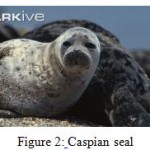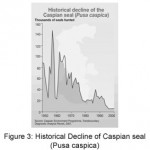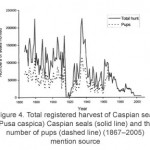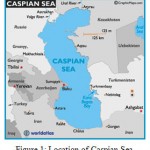Culture-driven Mortality in Caspian seal (Pusa caspica) at Southern Fringe of Caspian Sea
Nikta Moghaddamipour1 * , Parvin Farshchi1 , Esmail Kahrom1 and Mohammad Ali Mazhari2
1
Department of Energy and Environment,
Science and Research Branch,
Islamic Azad University,
Tehran,
Iran
2
Paya Boum Kav Company,
Tehran,
Iran
DOI: http://dx.doi.org/10.12944/CWE.9.1.07
Copy the following to cite this article:
Moghaddamipour N, Farshchi P, Kahrom E, Mazhari M. A. Culture-driven Mortality in Caspian seal (Pusa caspica) at Southern Fringe of Caspian Sea. Curr World Environ 2014;9(1) DOI:http://dx.doi.org/10.12944/CWE.9.1.07
Copy the following to cite this URL:
Moghaddamipour N, Farshchi P, Kahrom E, Mazhari M. A. Culture-driven Mortality in Caspian seal (Pusa caspica) at Southern Fringe of Caspian Sea. Curr World Environ 2014;9(1). Available from: http://www.cwejournal.org/?p=5931
Download article (pdf) Citation Manager Publish History
Select type of program for download
| Endnote EndNote format (Mac & Win) | |
| Reference Manager Ris format (Win only) | |
| Procite Ris format (Win only) | |
| Medlars Format | |
| RefWorks Format RefWorks format (Mac & Win) | |
| BibTex Format BibTex format (Mac & Win) |
Article Publishing History
| Received: | 2014-03-18 |
|---|---|
| Accepted: | 2014-04-15 |
Introduction
However, in many cases when human interferes with natural ecosystems and causes problems, these regulatory mechanisms cannot overcome human manipulation, which are often severe, and thus fail to offset or reduce damages. Sharma et al. (2014) stated that strong deterioration of environment and human health, which is, as a result of persistent organic pollutants, have been used in a wide range of agricultural and industrial supplies.2 A number of studies on the occurrence of persistent organic pollutants confirm their presence in various environmental components and human body.
Pusa caspica is a unique endangered species, that is found exclusively in the Caspian Sea (Figure 1)
|
|
Figure 1: Location of Caspian Sea Click here to View figure |
 |
Figure 2: Caspian seal Click here to View figure |
It is not clear till date how many seals survive in the Caspian Sea. Of one million seals during twentieth century, only 1,10,000 to 3,50,000 seals are predicted to inhabit the region now-a-days (Figure 3).
 |
Figure 3: Historical Decline of Caspian seal (Pusa caspica) Click here to View figure |
Baenninger (1991) examines historical aspects of violence, aggression, and cruelty to certain species. General treatment of animals to humans and vise versa is described. From socio-biological point of view, human predation, competition, or parasitism, cannot be considered as harshness and cruelty, unless these actions do not benefit humans or humanity. The other kind of interactions with other species has made possible varieties of violence that eventually produced restraining legislation in modern and industrial societies. The determinants of cruelty to animals, defined as intentional injury by an aggressor believes that animals share some human experiences and derive no benefit from the aggression3
The current culture of the Iranian society is such that people assume human apart from the nature, and its associated components; animate and inanimate.5 They are unaware that human survival depends on the nature’s balance. As a result, not only do they attempt to maintain the balance and their sodality with the nature, but also themselves undisputed owners of the nature, and see the land as their exploitation and dissipation area4 Human activities, today have generally, destroyed or severely disturbed many habitats, and only a few of these habitats have remained, while the number of habitats in which seals were concentrated was much higher ten years ago6
Habitat destruction may reduce the fertility, and hence population. It can even make seals more vulnerable to threats7 Declining populations of marine mammals including seals, virtually has disrupted the entire ecosystem. This article has identified the role of indigenous cultural conditions of Iranian society as a major cause of abnormal death of Caspian seal (Pusa caspica), and their population decline in order to be of an extensive help for the preservation of these valuable but vulnerable species.
Public Culture
People of different communities deal differently with their surrounding phenomena, that is based on the conditions of the society where they live, such as historical, religious, and economic conditions as well as customs and norms.(8) Although, it is obvious that there is no common cultural changing pattern, the direction of change has been devastatingly changing toward complexity.(9) Iranian people are among those communities with no proper behavior with the nature and natural surrounding phenomena. It can be generally said that they will be hostile with any creature that does not meet their needs, without hesitating a little about the reasons for their behavior.(10) As noted before, the reason is rooted in multiple social and cultural conditions and factors, which are beyond the scope of this article. Examples of such behavior are repelling birds, cats, and dogs or killing snakes and even insects that are sometimes beneficial. These violent behaviors are such that even animals in urban areas run as soon as people get close to them. These animals are considered semi-domestic and are seen in areas of high traffic and in close distance to humans in other countries like countries in Europe and etcThey even easily snatch food from people. For instance, there are pigeons in the squares and parks of European cities such as London . Even more interestingly, such violent behaviors against animals are not even observed in the children in these cities; this is evident that children are properly trained on that matter. This peaceful coexistence is rarely seen in Iran. Gullone and Robertson (2008) assessed the simultaneous engagement in animal abuse, and bullying behavior in 241 youngsters aged between 12 to 16 years. It was concluded that witnessing animal abuse was predictive which is both supportive of past research and authorizes further research attention. The findings have significant suggestions for the prevention and mediation of bullying and animal abuse behaviors11
General Education
Learning plays an important role in how the human being confronts various issues;Animal comfort laws in many countries require housing and treating animals in such a way that all of their species-specific needs can be satisfied and that they are not vulnerable to stress or pain (12), so that advanced countries have changed cultural factors such as some wrong values and norms, and even have built culture through proper planning in public education sector and succeeded. However, actions taken in Iran’s public education are not suitable for making changes in overall view of people, regarding nature and its living creatures, and people still consider themselves apart from nature and its components and exert a self-centered and inhumane attitude towards them. However, the human being is certainly a part of nature and the institutionalization of this view among people can be a major step towards the preservation of the nature.
Vocational training
Vocational training is a key factor in occupations. In other words, it is transferring all necessary knowledge, skills, and attitudes to individual for accurate performance of the tasks. Vocational training includes all side issues that are somehow associated with that profession, as well as issues surrounding the workplace. However, vocational training is not fully implemented in Iran because such training is not yet known in many jobs and even employers are completely unfamiliar with it. In some jobs with such trainings, not all employees benefit from it due to lack of facilities. Moreover, since this type of education have not been fully settled in Iran, the presented entries are not typically comprehensive and only technical aspects of the profession are discussed and not all aspects of the job. Finally, practitioners are not completely aware of their jobs and their relating issues.
The attitude and behavior of hunters as a group of people in the community
As a group of Iranian people, undoubtedly hunters possess the general characteristics of the community including culture, public education, and vocational training. The impact of hunting is often assumed to contain the high percentage of species (26.4%) listed as threatened with extinction in the IUCN Red Lis(13).In particular, social deficits are evident usually in lower social classes and hunters, as a group of people with mostly a degree of under high school diploma whose income from hunting cannot answer all their financial needs, are not exempt from this rule. According to what was said, erroneous views about the nature and its components have clearly penetrated among hunters of our society. Figure 4 shows the total hunting of Caspian seal (Pusa caspica) in recent years. As it can be seen, the culture of hunting has been changed over the past decades14
 |
Figure 4: Total registered harvest of Caspian seal (Pusa caspica) (solid line) and the number of pups (dashed line) (1867–2005) mention source Click here to View figure |
Officials’ Culture
The most essential factor for discipline, progress, and sustainable development in a community is the establishment of a system of scientific and efficient management at all decision-making and executive levels in the society. Therefore, countries with defects in these areas encounter numerous problems during their development. One of the most important problems is environmental issues which often arise from the lack of coordination between development programs and environmental conditions. In our country, evidence shows that the directors and officers of various departments have failed to take right decisions for dealing with these problems because they are part of the people of this community with educational and cultural conditions of the society, as mentioned. According to figures from the Iranian media, about $ 40 billion is lost annually due to poor decisions made by managers. As it was mentioned, although environmental issues are important, officials, directors, and employees are inattentive and indifferent even to the scope of their responsibility for environmental issues for reasons explained earlier and they do not prioritize these problems and do not feel responsible for them.
Conclusion
Iranian people are not adequately familiar with environmental phenomena and consider other creatures as dangerous enemies, or at least annoying. Therefore, when encountering them, they attempt to kill, harass, or at least scare them away. Officials are indifferent to environmental issues due to the lack of responsibility and unawareness of their duties and thus they do not attempt to prevent and resolve problems in this regard.
As a group in this community, hunters behave like most people when they encounter creatures in the environment, especially when they disturb their work and livelihood. In this case, this behavior is far more violent and more serious by hunters. Therefore, we cannot deny the relationship between the culture of the community in general and the behavior of hunters in particular and the deaths of seals.
Acknowledgment
We would like to express our sincere gratitude for the services rendered by Ravian Danesh Modit Company (Ravian D.M.) in providing insightful comments and proof-reading of the manuscript.
References
- Glenn R. Van Blaricom, Leah R. Gerber, Robert L. Brownell Jr. Encyclopedia of Biodiversity, 2ndedition, 64-93(2013)
- Cherry E, Jasper J. M.., Encyclopedia of Violence, Peace, & Conflict. 2ndedition, 64-74(2008)
- Baenninger R, Adv Phsychol., 76, 5-43(1991)
- Hoffman D.M., Int j Intercult Rel., 14, 275-299(1990)5. Arefi. M, City,Culture and Society., 4, 37-48(2013)
- Nakagiri. N, Sakisaka. Y, Togashi.T, Morita .S, Tainaka .K, Ecol Inform., 5, 241-247(2010)
- Ovaskainen .O, Math Biosci., 181, 165-176(2003)
- Reisinger. Y, , International Tourism, 263-288(2009)
- Goucher. C, LeGuin.Ch, and Walton.L, selections from chapter 2, “Changing Environments, Changing Societies.”
- O. Jones.International Encyclopedia of Human Geography, 2009, Pages 309-323
- Gullone. E, Robertson. N, J Appl Dev Psychol., 29, 371-379(2008)
- Keane. A, Brooke. M.de L, Mcgowan. P.J.K, Biol Conserv, 126, 216-233(2005)
- GRID-Arenda,l Historical decline of the Pusa caspica(Pusa caspica),
- Caspian Sea - State of Environment 2011
- Harkonen T, Harding KC, Wilson S, Baimukanov M, Dmitrieva L, et al. PLoS ONE., 7,e43130,(2012)








